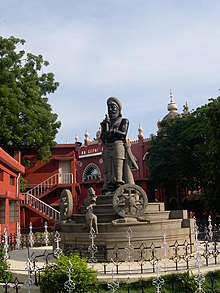Manu Needhi Cholan
This article needs additional citations for verification. (January 2009) |

Manu Needhi Cholan or Manuneedhi Cholan, also known as Elara, was a legendary Chola king believed to have killed his own son to provide justice to a Cow.Legend has it that the king hung a giant bell in front of his courtroom for anyone needing justice to ring. One day, he came out on hearing the ringing of the bell by a Cow. On enquiry he found that the Calf of that Cow was killed under the wheels of his chariot. In order to provide justice to the cow, he killed his own son Veedhividangan under the chariot as a punishment to himself i.e. make himself suffer as much as the cow.[1] Impressed by the justice of the king, Lord Shiva blessed him and brought back the calf and his son alive. He has been mentioned in the Silappatikaram and Periya Puranam.[2]His name has since then been used as a metaphor for fairness and justice in Tamil literature. His capital was Thiruvarur.
Chronicles such as the Yalpana Vaipava Malai and stone inscriptions like Konesar Kalvettu recount that Kulakkottan, an early Chola king and descendant of Manu Needhi Cholan, was the restorer of the ruined Koneswaram temple and tank at Trincomalee in 438 A.D., the Munneswaram temple of the west coast, and as the royal who settled ancient Vanniyars in the east of the island Eelam.[3][4]
Manu Needhi was also called as DharmaRajan. In the 'MahaVamsa', a historical poem of the Kings of Sri Lanka, tells of a Chola King who had identities similar to ManuNeedhi. MahaVamsa states that a King called Elara, a Chola King invaded the island in around 235 BC. It also adds that, he ruled 'with even justice toward friend and foe, on occasions of disputes at law,[1] and elaborates how he even ordered the execution of his son the basis of a heinous religious crime. The same chronicle relates that the king had a bell with a rope attached at the head of his bed, so that all who sought redress might ring it.In particular he is presented as a tireless defender of the native faith and of pointedly treating native Sinhala nobles with the same dignity as his Tamil associates. As such Elara is often held as the archetype of the Dharmaraja, or 'just king' of Buddhist tradition, all the more remarkable for not being a native son of the kingdom he governed.
From this Chronicle, The King's ordering of execution of his own son, and having a bell of justice can be related to Manu needhi's actions of killing his son for showing justice to the Cow and the bell which cow rang, as found in the first paragraph.
Also see
References
- ^ "From the annals of history". The Hindu. India. 25 June 2010.
- ^ "Tiruvarur in religious history of Tamil Nadu". The Hindu. Chennai, India. 16 July 2010.
- ^ Hellmann-Rajanayagam, Dagmar (1994). "Tamils and the meaning of history". Contemporary South Asia. 3 (1). Routledge: 3–23. doi:10.1080/09584939408719724.
- ^ Schalk, Peter (2002). "Buddhism Among Tamils in Pre-colonial Tamilakam and Ilam: Prologue. The Pre-Pallava and the Pallava period". Acta Universitatis Upsaliensis. 19–20. Uppsala University: 159, 503.
The Tamil stone inscription Konesar Kalvettu details King Kulakottan's involvement in the restoration of Koneswaram temple in 438 A.D. (Pillay, K., Pillay, K. (1963). South India and Ceylon);
